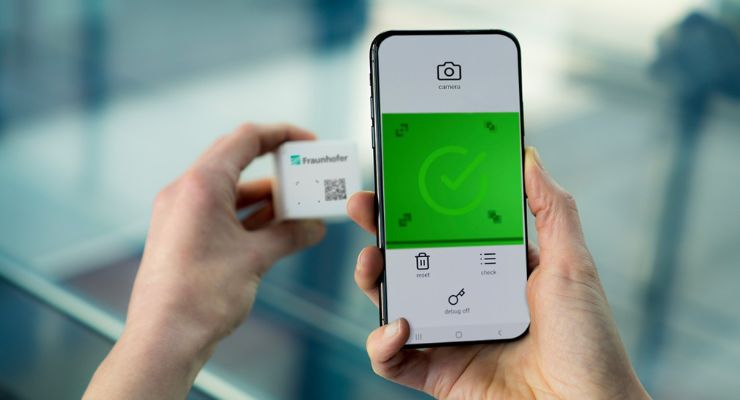A Smartphone Could Check for Counterfeit Medication
By Sam Brusco, Associate Editor | 11.14.23
The SmartID counterfeit-proof barcode system uses a smartphone to check a product is genuine.
The Fraunhofer Institutes for Applied Polymer Research IAP, for Secure Information Technology SIT and for Open Communication Systems FOKUS developed a new type of labeling system: SmartID.
The SmartID counterfeit-proof barcode system uses a smartphone to check a product is genuine, provided the manufacturer uses SmartID. It can be authenticated without connecting to a database. The consortium will exhibit a demonstration version of their SmartID at the joint Fraunhofer booth (Hall 3, Booth E74) at MEDICA 2023 in Düsseldorf from November 13 to 16, 2023.
“With SmartID, everyone in the supply chain can verify and authenticate a product that carries a SmartID code directly via a smartphone—offline, i.e., without having to connect to a database,” explains Dr. Tobias Jochum, project coordinator based at the Fraunhofer Center for Applied Nanotechnology CAN in Hamburg, a research outpost of Fraunhofer IAP, told the press. “We leverage the fact that all packaging has a unique, characteristic surface texture—similar to a human fingerprint—and that standard smartphone cameras are able to capture this surface texture.”
Information about the surface texture is digitized, then converted to a barcode printed on the packaging. The SmartID app is used to check if the info stored in the barcode matches the data captured from the surface texture. A counterfeit-proof barcode is created.
No IT infrastructure needs to be set up because verification and authentication take place in the SmartID app on the smartphone.
“One major requirement for the SmartID idea is that the barcode and the area needed for comparing the surface textures are as small as possible. As the project evolves, we will optimize the system in terms of the area required and also the sensitivity. Quantum materials will play a key role here. “These make it possible to detect significantly more surface texture features over a smaller area,” said Jochum.
The SmartID counterfeit-proof barcode system uses a smartphone to check a product is genuine, provided the manufacturer uses SmartID. It can be authenticated without connecting to a database. The consortium will exhibit a demonstration version of their SmartID at the joint Fraunhofer booth (Hall 3, Booth E74) at MEDICA 2023 in Düsseldorf from November 13 to 16, 2023.
“With SmartID, everyone in the supply chain can verify and authenticate a product that carries a SmartID code directly via a smartphone—offline, i.e., without having to connect to a database,” explains Dr. Tobias Jochum, project coordinator based at the Fraunhofer Center for Applied Nanotechnology CAN in Hamburg, a research outpost of Fraunhofer IAP, told the press. “We leverage the fact that all packaging has a unique, characteristic surface texture—similar to a human fingerprint—and that standard smartphone cameras are able to capture this surface texture.”
Information about the surface texture is digitized, then converted to a barcode printed on the packaging. The SmartID app is used to check if the info stored in the barcode matches the data captured from the surface texture. A counterfeit-proof barcode is created.
No IT infrastructure needs to be set up because verification and authentication take place in the SmartID app on the smartphone.
“One major requirement for the SmartID idea is that the barcode and the area needed for comparing the surface textures are as small as possible. As the project evolves, we will optimize the system in terms of the area required and also the sensitivity. Quantum materials will play a key role here. “These make it possible to detect significantly more surface texture features over a smaller area,” said Jochum.














